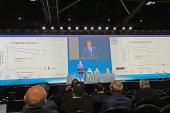Surgical Turndown Patients Need Better Risk Estimation Tools: OPTIMUM
This understudied population is not well defined, and experts call for better use of risk scores to determine their optimal care path.

Because real-world patients who are turned down for CABG but end up undergoing PCI with optimal medical therapy are complex and carry a high burden of comorbidity, they need better risk assessment than what is currently available, according to experts commenting on the now-published OPTIMUM results.
The most-telling reason for this, they argue, is because short-term mortality for these patients was substantially lower than what was projected by the evaluating surgeons even though currently available surgical risk models were reasonably accurate.
“There's this growing population who really their best option is probably not bypass surgery just because of prohibitive risk of the procedure,” lead author Adam C. Salisbury, MD, MSc (Saint Luke’s Mid America Heart Institute, Kansas City, MO), told TCTMD, adding that it’s been challenging to know even how to treat them with PCI. And they haven’t been well studied before now, he said. “Essentially, what we were going off of is institutional experience, personal experience, and limited studies from single centers.”
Salisbury said he hopes these initial results of the OPTIMUM study—which were originally presented at TCT 2021 and are now published in the February 13, 2023, issue of JACC: Cardiovascular Interventions—will highlight the importance of using mortality risk prediction models and eventually health status risk prediction models.
“The next stage of some of our analyses is to understand how complete a revascularization they benefit from in the sense that an older, more-frail person [may require] an aggressive revascularization plan [compared with] a patient who might be younger and has other reasons driving their surgical ineligibility,” he said. “So we're really hoping to use these data not only to inform future trials but to really inform that discussion that we hope is happening at more and more centers where surgeons and interventional cardiologists and general cardiologists are all trying to understand who is going to do well with our interventions and really offer them some useful information to help patients pick the right path for them.”
Commenting on the study for TCTMD, cardiac surgeon Marc Ruel, MD, MPH (University of Ottawa Heart Institute, Canada), agreed, but with a caveat. “[OPTIMUM] doesn't answer the question whether what was provided to these patients is better than optimized medical therapy alone,” he said. “And we also don't know if these patients had been operated on, would they have done better in the long-term. We don't have that information. Or maybe they would have done worse as well. We don't really know.”
Because the reasons for why the patients in this study were turned down for surgery aren’t well defined, Ruel continued, “whether this can be externally validated in everyday clinical practice at other centers is still a question in my mind.” The findings continue to support the use of heart team decision-making, but “I would be careful in saying that patients who are turned down for surgery need guideline-recommended medical therapy and PCI and therefore do well based on the results of this paper.”
OPTIMUM Results
As previously reported by TCTMD, Salisbury and colleagues prospectively enrolled 726 patients (mean age 70 years; 68.5% male) who were considered ineligible for CABG from 22 institutions and who underwent PCI with optimal medical therapy between December 2016 and July 2019. Mean SYNTAX score was 32.4 before and 15.0 after PCI.
All-cause mortality was 5.6% and 12.3% at 30 days and 6 months, respectively. The observed-to-expected mortality ratios were similar for both the STS score (1.06; 95% CI 0.71-1.36) and the EuroSCORE II (0.99; 95% CI 0.71-1.27), but the referring cardiac surgeons overestimated mortality (0.59; 95% CI 0.42-0.77) and the NCDR CathPCI score underestimated it (4.46; 95% CI 2.35-7.99).
From baseline to 6 months, both the Seattle Angina Questionnaire summary score (65.9 vs 86.5) and Kansas City Cardiomyopathy Questionnaire summary score (54.1 vs 82.6; P < 0.0001 for both) predicted improvements in health status.
Salisbury said while he anticipated this cohort to be sick and have a high mortality, “it was certainly higher than we initially anticipated with this treatment. However, I think much of that really reflects their underlying complexity.”
Notably, the study shows that “these patients can often achieve remarkable improvements in their health status and their functional status after treatment with medical therapy and PCI, which is often for really sick, often elderly patients,” he continued. “So their primary goal is to feel better and function better, and we saw quite robust improvements in their function over the course of follow-up.”
‘Jumping Off Point’
In an accompanying editorial, John A. Bittl, MD (American College of Cardiology, Washington, DC), and Robert L. Feldman, MD (AdventHealth Ocala, FL), point out that PCI in this study was not likely the sole reason behind the improvements seen. “First, it is not likely that all patients with chest discomfort in this cohort had angina,” they write. “Second, without a medical control group, it is unclear what the added benefit of PCI over guideline-directed medical therapy would have been in a group of patients who were ill enough to be considered for revascularization because of clinical instability.”
Bittl and Feldman say an important takeaway from the study is that mortality risk scores for patients turned down for surgery should be shared with them as part of the informed consent process. “The selection of the appropriate mortality prediction tool is important, and assuming that the high mortality rate was not due to PCI complications, we believe that a scoring system based on age, acuity, and comorbidities would have better predictive accuracy than a PCI score based on anatomy or procedural risk,” they write, adding that the STS score or EuroSCORE II are currently “preferable” to the NCDR CathPCI score here.
Ruel praised the efforts that have gone into the development of the STS score especially, and said “it should be used,” but something similar is needed for PCI that “goes beyond addressing the severity of coronary heart disease but also the patient and the risk factors that would lead to morbidity and mortality.”
Another step toward making sure these patients are treated appropriately could be something that is done at his institution, where any patient who is turned down for surgery receives an automatic second surgical opinion, according to Ruel. “I think sometimes you'll be surprised,” he said. “We know that often these patients who are turned down for surgery are considered by another surgeon to be operable and do well.”
Salisbury also stressed the importance of collaborative risk management for these patients, noting that more work should be done in this area. However, he pointed out, “over the course of the study, it was often the case that it was cardiac surgeons who were referring us patients to enroll in the study. They'd see somebody who they found was high risk that they thought would do well with a PCI procedure and with medical therapy and would call their interventional colleagues. So it wasn't just cardiologists referring to surgeons. It worked the other way as well, which I think is really a great example of how a healthcare system with a good, functional heart team can work.”
The editorialists say the findings continue to support the “pivotal role” of the heart team, despite no randomized data showing that this strategy is objectively better. “When patients, cardiologists, and surgeons come together as a team, patients get the best care.”
Salisbury said his team plans to use this study as a “jumping off point” for a series of studies to look at outcomes in this population and specify the most-important prognostic factors. “An example might be: are patients who are very elderly and frail with a poor functional status likely to have the same outcomes as people who are otherwise in a little more robust shape but have poor targets for surgical intervention? [We’d like to] understand how these different subpopulations do with our current treatments and then really inform studies going forward to help define better, more-systematic approaches to managing these patients.”
Yael L. Maxwell is Senior Medical Journalist for TCTMD and Section Editor of TCTMD's Fellows Forum. She served as the inaugural…
Read Full BioSources
Salisbury AC, Grantham JA, Brown WM, et al. Outcomes of medical therapy plus PCI for multivessel or left main CAD ineligible for surgery. J Am Coll Cardiol Intv. 2023;16:261-273.
Bittl JA, Feldman RL. Converting surgical turndowns into PCI successes. J Am Coll Cardiol Intv. 2023;16:274-276.
Disclosures
- The study was supported by Boston Scientific.
- Salisbury reports receiving consulting and advisory board fees from Medtronic; and institutional grant support from Boston Scientific and Abiomed.
- Feldman reports serving as a consultant to Boston Scientific.
- Bittl and Ruel report no relevant conflicts of interest.





Comments